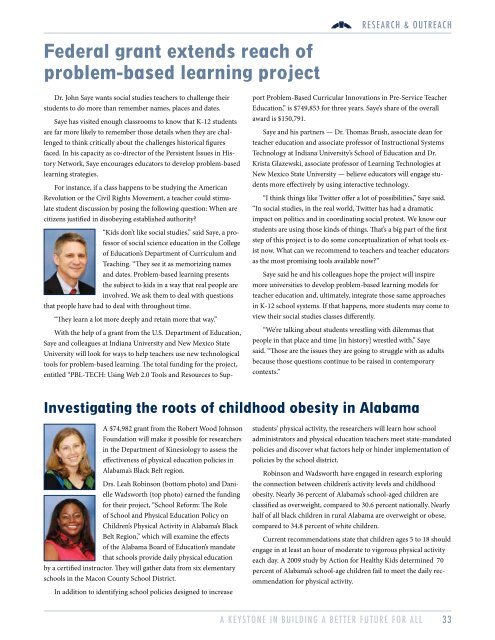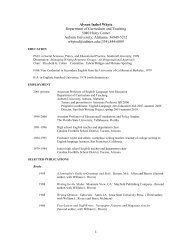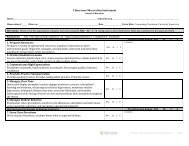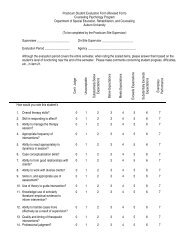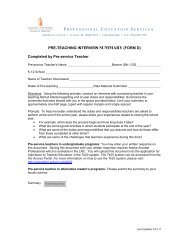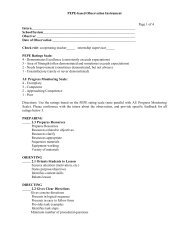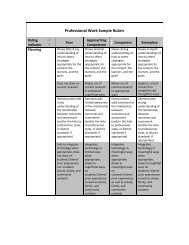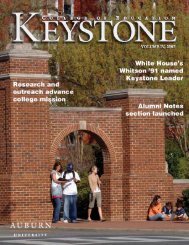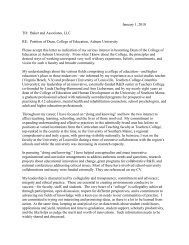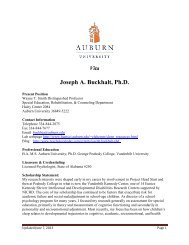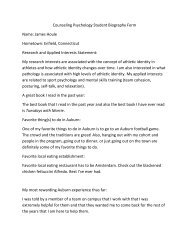8.1MB - College of Education - Auburn University
8.1MB - College of Education - Auburn University
8.1MB - College of Education - Auburn University
Create successful ePaper yourself
Turn your PDF publications into a flip-book with our unique Google optimized e-Paper software.
e s e a rc h & o u t r e ach<br />
Federal grant extends reach <strong>of</strong><br />
problem-based learning project<br />
Dr. John Saye wants social studies teachers to challenge their<br />
students to do more than remember names, places and dates.<br />
Saye has visited enough classrooms to know that K-12 students<br />
are far more likely to remember those details when they are challenged<br />
to think critically about the challenges historical figures<br />
faced. In his capacity as co-director <strong>of</strong> the Persistent Issues in History<br />
Network, Saye encourages educators to develop problem-based<br />
learning strategies.<br />
For instance, if a class happens to be studying the American<br />
Revolution or the Civil Rights Movement, a teacher could stimulate<br />
student discussion by posing the following question: When are<br />
citizens justified in disobeying established authority?<br />
“Kids don’t like social studies,” said Saye, a pr<strong>of</strong>essor<br />
<strong>of</strong> social science education in the <strong>College</strong><br />
<strong>of</strong> <strong>Education</strong>’s Department <strong>of</strong> Curriculum and<br />
Teaching. “They see it as memorizing names<br />
and dates. Problem-based learning presents<br />
the subject to kids in a way that real people are<br />
involved. We ask them to deal with questions<br />
that people have had to deal with throughout time.<br />
“They learn a lot more deeply and retain more that way.”<br />
With the help <strong>of</strong> a grant from the U.S. Department <strong>of</strong> <strong>Education</strong>,<br />
Saye and colleagues at Indiana <strong>University</strong> and New Mexico State<br />
<strong>University</strong> will look for ways to help teachers use new technological<br />
tools for problem-based learning. The total funding for the project,<br />
entitled “PBL-TECH: Using Web 2.0 Tools and Resources to Support<br />
Problem-Based Curricular Innovations in Pre-Service Teacher<br />
<strong>Education</strong>,’’ is $749,853 for three years. Saye’s share <strong>of</strong> the overall<br />
award is $150,791.<br />
Saye and his partners — Dr. Thomas Brush, associate dean for<br />
teacher education and associate pr<strong>of</strong>essor <strong>of</strong> Instructional Systems<br />
Technology at Indiana <strong>University</strong>’s School <strong>of</strong> <strong>Education</strong> and Dr.<br />
Krista Glazewski, associate pr<strong>of</strong>essor <strong>of</strong> Learning Technologies at<br />
New Mexico State <strong>University</strong> — believe educators will engage students<br />
more effectively by using interactive technology.<br />
“I think things like Twitter <strong>of</strong>fer a lot <strong>of</strong> possibilities,” Saye said.<br />
“In social studies, in the real world, Twitter has had a dramatic<br />
impact on politics and in coordinating social protest. We know our<br />
students are using those kinds <strong>of</strong> things. That’s a big part <strong>of</strong> the first<br />
step <strong>of</strong> this project is to do some conceptualization <strong>of</strong> what tools exist<br />
now. What can we recommend to teachers and teacher educators<br />
as the most promising tools available now?”<br />
Saye said he and his colleagues hope the project will inspire<br />
more universities to develop problem-based learning models for<br />
teacher education and, ultimately, integrate those same approaches<br />
in K-12 school systems. If that happens, more students may come to<br />
view their social studies classes differently.<br />
“We’re talking about students wrestling with dilemmas that<br />
people in that place and time [in history] wrestled with,” Saye<br />
said. “Those are the issues they are going to struggle with as adults<br />
because those questions continue to be raised in contemporary<br />
contexts.”<br />
Investigating the roots <strong>of</strong> childhood obesity in Alabama<br />
A $74,982 grant from the Robert Wood Johnson<br />
Foundation will make it possible for researchers<br />
in the Department <strong>of</strong> Kinesiology to assess the<br />
effectiveness <strong>of</strong> physical education policies in<br />
Alabama’s Black Belt region.<br />
Drs. Leah Robinson (bottom photo) and Danielle<br />
Wadsworth (top photo) earned the funding<br />
for their project, “School Reform: The Role<br />
<strong>of</strong> School and Physical <strong>Education</strong> Policy on<br />
Children’s Physical Activity in Alabama’s Black<br />
Belt Region,’’ which will examine the effects<br />
<strong>of</strong> the Alabama Board <strong>of</strong> <strong>Education</strong>’s mandate<br />
that schools provide daily physical education<br />
by a certified instructor. They will gather data from six elementary<br />
schools in the Macon County School District.<br />
In addition to identifying school policies designed to increase<br />
students’ physical activity, the researchers will learn how school<br />
administrators and physical education teachers meet state-mandated<br />
policies and discover what factors help or hinder implementation <strong>of</strong><br />
policies by the school district.<br />
Robinson and Wadsworth have engaged in research exploring<br />
the connection between children’s activity levels and childhood<br />
obesity. Nearly 36 percent <strong>of</strong> Alabama’s school-aged children are<br />
classified as overweight, compared to 30.6 percent nationally. Nearly<br />
half <strong>of</strong> all black children in rural Alabama are overweight or obese,<br />
compared to 34.8 percent <strong>of</strong> white children.<br />
Current recommendations state that children ages 5 to 18 should<br />
engage in at least an hour <strong>of</strong> moderate to vigorous physical activity<br />
each day. A 2009 study by Action for Healthy Kids determined 70<br />
percent <strong>of</strong> Alabama’s school-age children fail to meet the daily recommendation<br />
for physical activity.<br />
A K e y s t o n e i n B u i l d i n g a B e t t e r F u t u r e f o r A l l 3 3


